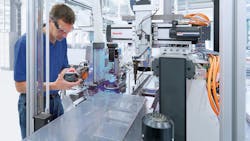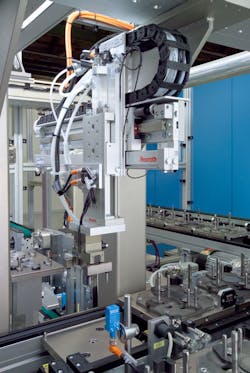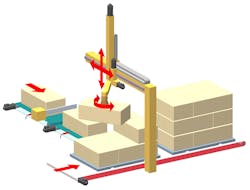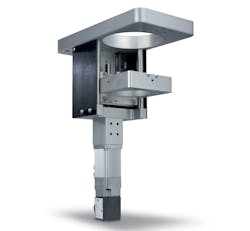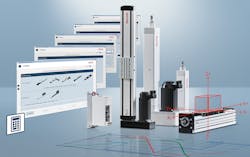The Benefits of Subassemblies for Automation
Constant pressures to improve the efficiency and flexibility of the automated machines they build is driving OEMs and end-users to seek suppliers that can deliver complete packages versus committing their own resources to engineering and developing them. There are several key industry factors driving this movement.
- Focusing on core competencies: OEMs that build highly specialized machines realize the value of concentrating engineering resources on improving their machines’ core functions. This makes it more attractive to outsource creation of motion functions to suppliers with proven expertise.
- Combining control and mechanical functions: Machine builders and users recognize the benefits of treating motion technologies as a single discipline. Combining several technologies into complete subassemblies delivers economies of scale and design advantages.
- Next-generation engineers: Recent engineering grads may be more inclined toward using multi-function subassemblies than their predecessors due to engineering roles becoming more demanding in increasingly lean-running companies.
- Retrofitting existing production lines: To meet the demand for customization and Industry 4.0 capabilities, manufacturers are retrofitting production lines. Using subassemblies with open engineering control interfaces that communicate with existing systems, regardless of programming language, simplifies the transitions.
- Supplier consolidation: Rather than relying on several suppliers, engineering staff and purchasing agents want one source to engineer, combine and supply as many components as possible.
- End-user globalization of the end-user: Global supply chains lead many manufacturers to seek OEMs that support their products, from engineering through delivery and long-term maintenance.
Subassembly Applications
In many applications, ready-to-use subassemblies built from standard equipment readily meet customer requirements. However, these subassemblies often require custom engineering to address special or unique specifications. With either scenario, there are advantages to working with a single-source supplier to provide both.
Ready-to-use machines made with standard linear modules and preconfigured control function blocks can be suitable for applications such as material transport between production lines. Other applications include pick-and-place machines, automated storage and retrieval, and palletizing and tool handling for machining operations.
For more intricate and unique projects, custom-engineered subassemblies solve the challenges of precision motion profiles, tooling accuracy and eliminating vibrations in complex manufacturing systems. For example, in the semiconductor manufacturing industry, our engineers developed a wafer-lift subassembly for ultra-smooth motion when moving delicate semiconductor wafers between process points. They created a cost-effective subassembly using the company’s ball screws and servo motors with the existing machine. This subassembly exceeded a 5-million-cycle target and lowered costs by a 30% cost compared to an OEM in-house version.
In another application, our team designed a linear transport subassembly to move laboratory samples within a medical diagnostic tool. The compact subassembly required precise engineering to fit within the existing machine. The result was a cost-effective design which let the machine to concentrate its engineers on its core competencies.
Choosing a Subassembly
Efficiency, reliability and long-term maintainability depend on component performance and the supplier’s engineering capabilities. A prerequisite for choosing is fully understanding that company’s capabilities, including its motion products, engineering resources and experience, and its manufacturing capabilities.
A supplier’s strength in motion subassemblies represents more than just proven products in thousands of installations worldwide. It is critical they have both premium products and engineering expertise. Engineering expertise includes a thorough knowledge of design requirements to size, select and combine appropriate components, and experience programming motion control systems.
It is important to consider design factors when working with suppliers to get the full advantage subassemblies’ versatility and cost-savings. For example, a design team should look at the mechanics before designing the electronics and controls design. Specifying electrical components before the mechanics can waste time and led to rework.
The system’s mechanical components influence parameters such as motor inertia and torque. And mechanical factors of load, orientation, speed, travel, precision, operating environment and duty cycle are critical. By not nailing down the mechanics first can lead to selecting unnecessarily large or expensive mechanical systems later.
For example, if the OEM or end-user forces a design to use a specific motor without considering these criteria, it may take larger mechanical components to handle the motor torque or inertia than what was needed.
Designers should also consider the motion controller and drives so they are compatible with the linear drive’s characteristics. Motion controller and drive parameters must have the correct, safe torque and end-of-stroke limits programmed to ensure the linear module does not overshoot its limits and crash. Likewise, if a ball-screw-driven module has 0.010-mm positional repeatability, the encoder must meet or exceed this specification; otherwise, you won’t be able to fully benefit from the ball screw’s precision.
An oversized motor could potentially exceed a module’s torque limit, causing mechanical failure or inertia and settling issues. Unpredictable settling can be a problem for precision applications. Too much motor inertia for the module may make it hard to reach the desired position, so overall cycle times may be too long. it is imperative to size the mechanical and electrical components together to achieve an ideal one-to-one inertia ratio, or as close as possible to this ratio, especially when precision is critical. Minimum power consumption is also important for customers looking to reduce their environmental impact.
Similarly, selecting linear modules based on inaccurately overestimated performance criteria can lead to more complexity and expense than necessary. The ideal supplier will offer a range of appropriate mechanical drive options to meet performance criteria, including ball screw, toothed belts and linear motor drives. It is also important to ensure the supplier’s electrical and mechanical engineers understand and communicate all the established parameters for each linear module.
Working with Suppliers
To get motion subassemblies that meet a given project requirements, work with suppliers that will test the operation with state-of-the-art production equipment and quality processes. Key capabilities to evaluate include:
- Product qualification plans with documented controls related to manufacturing.
- Standardized Supplier Quality Assessment (SSQA) programs that include complete enterprise audits.
- Reliability testing.
- Precision measurement abilities, including laser inspecting finished subassemblies if needed.
- Major industry certifications, including ISO 9001, ISO 14001 and ISO 18001.
Finally, besides product portfolio and manufacturing capabilities, it is also important to consider the supplier’s global and local resources for collaborative engineering, project management and support. Meeting these criteria is crucial for a subassembly supplier looking to join forces with customers in developing mechatronic systems that meet performance, manufacturing and cost-savings requirements.
Richard Hansen is a senior automation engineer and Richard Vaughn is the automation engineering manager at the Bosch-Rexroth Corp.
